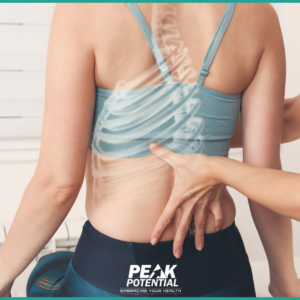
I have heard many conversations lately (both in person and online) about bladder leakage. Everyone seems to be peeing a little bit when they lift, run, or laugh.
It’s joked about with new moms, athletes, and menopausal women like it is inevitable. The issue is no joke! It’s a problem with the pelvic floor muscles and although it is very common, it is NOT normal.
Your pelvic floor muscles are an internal hammock that supports the pelvic organs. We use these muscles to:
- consciously control our bowel and bladder
- perform sexual functions
- assist the birthing process
- stabilize the spine
As we age, these muscles can weaken and no longer function in an optimal manner. The risk for problems increases with childbirth, menopause, abdominal surgery, obesity, smoking, and chronic constipation.
These risk factors are true for A LOT of individuals. Again, just because something is common does not mean it is normal.
To say it is normal is to say that there is nothing to be done to change it. And there is absolutely a lot you can do to improve the function of your pelvic floor and regain your freedom and dignity. You just need to cut through the myths that surround this delicate subject.
MYTH #1 – Everyone needs to do Kegels for a strong pelvic floor.
The only thing usually discussed in regards to pelvic floor is Kegel exercises. These involve squeezing your pelvic floor muscles to improve strength.
However, many women do Kegels incorrectly. This can worsen conditions such as incontinence, pelvic pain, and even low back pain.
MYTH #2 – Pelvic floor problems only occur when the muscles are weak.
Many clients who work on Kegels without relief of their symptoms actually have a different kind of problem not related to weakness. In these cases, the muscles are actually too tight.
For the muscles to function correctly they must be able to both contract and relax, just like any other muscle in your body. Therefore, training must be done to relax the muscle before any strengthening such as Kegels should be initiated.
MYTH #3 – I’m too old to strengthen my pelvic floor muscles.
As many people age, they resign themselves to urinary incontinence or give up on sexual activity due to pain. They believe they are just “too old” to improve upon their pelvic floor and regain their freedom.
This is not true! Research shows that age is no barrier to the benefits of strengthening exercise, and that includes the pelvic floor muscles.
Myth #4 – I’m a man so I don’t need pelvic floor exercises.
Men often think they are off the hook because pelvic floor problems are frequently associated with pregnancy and menopause. However, men do have essentially the same pelvic floor muscles as women.
Therefore, they can reap similar benefits regarding pelvic, back, sexual, urinary, and bowel health. Most notably for men, these muscles must be trained to improve bladder control after prostate surgery.
Myth #5 – I have a strong core so I have a strong pelvic floor.
When we discuss “core muscles” we refer to abdominal, low back, and pelvic floor muscles. It’s often hard to identify the difference between each of these since they work together.
However, a six pack does not mean you have strong pelvic floor muscles, because abdominal exercise won’t directly strengthen the pelvic floor. Specific pelvic floor exercise are needed to strengthen the pelvic floor.
TRUTH. . . we can’t ignore our pelvic floor!
Exercises to improve the function of the pelvic floor must address the deep muscles of the abdominal wall. By improving muscle flexibility, strength, coordination, and body awareness we can improve muscle function and lower the risk of incontinence, sexual dysfunction, and pelvic pain.
When problems occur during pregnancy, menopause, post surgically, or with age an individualized program may be needed. Specifically in cases of post partum pelvic pain, studies found that optimal results are achieved with the help of a physical therapist who addresses the entire spinal musculature and pelvic alignment through an individually guided program.
Physical Therapy . . . . Seriously?
Yes, the pelvic floor is made of muscles and interacts with bones, tendons, and ligaments. Physical therapists are experts in the musculoskeletal system, so we are well trained in addressing these concerns from the outside. Better yet, we use an integrative approach to address how your pelvic floor interacts with your entire body and the other lifestyle factors affecting your complaints.
Have questions about how a Doctor of Physical Therapy could help you? Just click the link below to set up a free phone call to get some answers and put your mind at ease.




